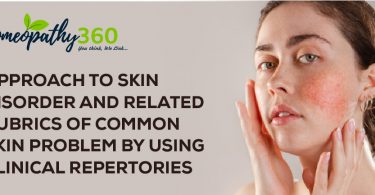-Dr Reteka Sexena
MD Scholar, Dr MPK Homoeopathic Medical College, Hospital & Research Center
(under Homoeopathy University), Saipura, Jaipur, Rajasthan; Former Senior Research Fellow (Homoeopathy), Central Council for Research in Homoeopathy, Ministry of AYUSH, Government of India.
Abstract
Vitiligo is a common chronic skin depigmentation disorder. It is considered to be a social stigma, particularly for young girls. Despite its high prevalence and old history, its etiopathogenesis is complex and enigmatic. This article aims to summarise the etiopathogenesis of Vitiligo put forward through various theories so far and highlights the role of Psoralea corylifolia mother tincture as an external application in the treatment of Vitiligo.
Keywords: Vitiligo, depigmentation, Psoralea corylifolia
Introduction
Vitiligo is a commonly acquired depigmentation disorder of the skin which affects about 1% of people worldwide and is phenotypically characterized by white spots on skin secondary to selective destruction of melanocytes.1,2
Clinically, two major subtypes of vitiligo are well recognized: Non-segmental and Segmental. non-segmental Vitiligo (NSV) is the more common subtype, having asymmetrical, non-dermatomal distribution usually with a gradual onset. Segmental Vitiligo (SV) is less common and is characterized by a unilateral dermatomal distribution which usually has an early rapid onset and stabilizes in a limited location once fully developed.3
The prevalence of vitiligo is high ranging from 0.005 to 0.38% cases worldwide.4,5 The state of Gujarat has been reported to have a prevalence of 8.8%, the highest in the world.6,7
Clinical Presentation
Vitiligo is a common and easily recognized disorder which is characterized by white spots typically first noted on the fingers, knuckles, around the eyes and mouth, and on the feet and genitalia. 8,9
Etio- pathogenesis:
Vitiligo is an autoimmune condition in which multiple immune response genes are believed to be involved.10 Prolonged periods of psychological stress might be involved in the onset and progression of vitiligo. These associations may support the view that psychological stress and the onset of autoimmune conditions are closely connected.11,12
Studies have shown that vitiligo may be caused by a response to oxidative stress, mediated by T-cells and involving mediators such as tumour necrosis factor-alpha (TNFa), heat shock protein 70 (Hsp70), and interleukin 1 alpha (IL-1a).13,14,15
Stress responses in vitiligo
The onset of vitiligo can be instigated by various triggers like sunburn and exposure to phenolic chemicals; however, the trigger is not known in most cases. The triggers are all thought to induce oxidative stress in melanocytes.16 Individuals with Vitiligo have been reported to have compromised antioxidant responses, with enzymes such as superoxide dismutase (SOD) present at higher-than-expected levels in tissue from perilesional areas and in sera.17,18 The key role of antioxidants in vitiligo has been suggested by a candidate gene association study, which found a significant association between single nucleotide polymorphism (SNP) rs3565214 within the anti-oxidant gene (NRF2) and vitiligo in the Chinese population.19 There are multiple mechanisms through which excessive melanocyte oxidative stress can translate to an autoimmune reaction.
The autoimmune component
CD8+ T cells specific to and capable of killing, melanocytes are increased in the blood of those with vitiligo compared to healthy controls, and numbers correlate with disease activity.20
Major Susceptibility Genes
Various antioxidant genes NRF2, UPR gene XBP1, and numerous immune-related genes including class I and class II major histocompatibility loci located on chromosome 6p21.3 have been associated with a risk for developing vitiligo.20
Role of Psoralea corylifolia mother tincture as an external application in Vitiligo
Vitiligo is an emerging clinical condition throughout the world but is difficult to treat. Psoralea corylifolia, commonly known as babchi, is a popular herb which was used traditionally in Ayurvedic and Chinese medicine to cure various skin diseases. This plant is also pharmacologically studied for its chemo-protective, anti-oxidant, anti-microbial and anti-inflammatory properties.21
- corylifoliais a known to be an ancient remedy for vitiligo.22, 23 The furanocoumarins (obtained from the seeds of the plant) contain psoralens which promote pigmentation and thus fights vitiligo.24
The drug appears to have a purely local action with a specific effect on the arterioles of the sub-capillary plexuses, which are dilated so that the plasma is increased in this area. The skin becomes red and the melanoblasts (pigment-forming cells) are stimulated to form pigments, which gradually diffuse into the white patches of vitiligo. 25,26 Also, the phytochemically induced covalent binding of the drug to pyrimidine bases is responsible for its therapeutic effect. The photo-conjunction involves thymine dimer adducts on the opposite strands of DNA. Psoralen has been found to intercalate into DNA, where they form mono- and di-adducts in the presence of long-wavelength UV light and thus are effective in the treatment of hypo-pigmented lesions of the skin.27
Commonly Indicated Homoeopathic Medicines in Vitiligo: 28,29
- TUBERCULINUM – Treatment may be started with this remedy.
- ARS. SULPH. FLAVATUM – Vitiligo especially at mucocutaneous junction.
- HYDROCOTYLE – If Ars sulph flav fails, this remedy may be tried.
- CALCAREA CARB- Vitiligo with milky white spots on skin appearing anywhere on the body.
- BORAX – White skin with red patches
- ARSENICUM ALB- Dry, rough skin with whitish spots; skin complaint alternating with respiratory complaints like asthma.
- CAUSTICUM – Vitiligo from burns
- SEPIA- Vitiligo at the tip of the penis
- NITRIC ACID-Vitiligo especially at the mucocutaneous junction; discoloured zigzag patches on the skin with raw flesh appearing base
- STAPHYSAGRIA- Vitiligo at the tip of the penis. Itching, scratching changes location of itching.
- SULPHUR- Itchy, burning skin with white spots on the skin.
- NATRUM MUR- Dry and chapped skin; greasy, oily skin especially on hairy parts.
- ARSENIC ALBUM- Intense itching after the suppressed eruption; brownish-white spots in the skin; dry, rough, scaly dirty, shrivelled.
Conclusion
Although not associated with any physical discomfort vitiligo causes considerable psychological morbidity. The treatment, however, is prolonged and needs to be based on homoeopathic principles of totality and constitutional treatment. A larger number of studies on strong evidence-based parameters, with rigorous study designs including RCTs with validated scales, are essentially required to be conducted to develop an evidence base of Homoeopathy for vitiligo treatment.
References:
- Le Poole IC, Das PK, van den Wijngaard RM, et al.: Review of the etiopathomechanism of vitiligo: a convergence theory. Exp Dermatol. 1993; 2(4): 145–53.
- Glassman SJ. Vitiligo, reactive oxygen species and T-cells. Clin Sci. 2011; 120:99-120.
- Arora AK, Kumaran MS. Pathogenesis of vitiligo: An update. Pigment Int. 2017; 4:65-77.
- Lu T, Gao T, Wang A, Jin Y, Li Q, Li C. Vitiligo prevalence study in Shaanxi Province, China. Int J Dermatol. 2007; 46:47-51.
- Howitz J, Brodthagen H, Schwartz M, Thomsen K. Prevalence of vitiligo. Epidemiological survey on the Isle of Bornholm, Denmark. Arch Dermatol 1977; 113:47-52.
- Das SK, Majumder PP, Chakraborty R, Majumdar TK, Haldar B. Studies on vitiligo. I. Epidemiological profile in Calcutta, India. Genet Epidemiol 1985; 2:71-8.
- Dwivedi M, Laddha NC, Shajil EM, Shah BJ, Begum R. The ACE gene I/D polymorphism is not associated with generalized vitiligo susceptibility in Gujarat population. Pigment Cell Melanoma Res 2008; 21:407-8.
- Nordlund J J, Ortonne JP. Vitiligo Vulgaris. In: Nordlund JJ, Hearing VJ, King RA, Oetting W, Ortonne JP, editor. The pigmentary system: Physiology and pathophysiology. Oxford: Blackwell Scientific, Inc; 2006. p. 591-8.
- Hann SK, Nordlund JJ, editors. Vitiligo: A Monograph on the Basic and Clinical Science. 1 st ed. Oxford, London: Blackwell Science Ltd; 2000. p. 1-386.
- Jin Y, Birlea S, Fain P et al: Variant of TYR and autoimmunity susceptibility loci in generalized vitiligo. New Engl J Med. 2010; 362(18): 1686–97.
- Trapp E, Trapp M, Sampogna F et al. Autonomic nervous tone in Vitiligo patients – A Case-Control Study. Acta Derm Venereol. 2015; 95(2): 169–72.
- Mahesh S, Mallappa M, Tsintzas D, Vithoulkas G. Homoeopathic Treatment of Vitiligo: A Report of Fourteen Cases. Am J Case Rep. 2017; 18: 1276-1283.
- Alghamdi KM, Khurrum H, Taieb A, Ezzedine K: Treatment of generalized vitiligo with anti-TNF-a agents. J Drugs Dermatol. 2012; 11(4): 534–39.
- Manga P, Elbuluk N, Orlow SJ: Recent advances in understanding vitiligo. F1000Research, 2016; 5: F1000 Faculty Rev-2234
- Eleftheriadou V, Whitton M, Gawkrodger D et al: Future research into the treatment of vitiligo: where should our priorities lie? Results of the vitiligo priority setting partnership. Br J Dermatol, 2011; 164(3): 530–36.
- Picardo M, Bastonini E: A New View of Vitiligo: Looking at Normal-Appearing Skin. J Invest Dermatol. 2015; 135(7): 1713–4.
- Yildirim M, Baysal V, Inaloz HS, et al.: The role of oxidants and antioxidants in generalized vitiligo. J Dermatol. 2003; 30(2): 104–8.
- Dammak I, Boudaya S, Ben Abdallah F, et al.: Antioxidant enzymes and lipid peroxidation at the tissue level in patients with stable and active vitiligo. Int J Dermatol. 2009; 48(5): 476–80.
- Song P, Li K, Liu L, et al.: Genetic polymorphism of the Nrf2 promoter region is associated with vitiligo risk in Han Chinese populations. J Cell Mol Med. 2016; 1–11.
- Manga P, Elbuluk N and Orlow SJ. Recent advances in understanding vitiligo [version 1; referees: 3 approved] F1000Research 2016, 5(F1000 Faculty Rev):2234 (DOI: 10.12688/f1000research.8976.1
- Khushboo PS, Jadhav VM, Kadam VJ, Sathe NS. Psoralea corylifolia Linn. “Kushtanashini”. Pharmacogn Rev. 2010; 4(7):69-76.
- Sah P, Agrawal D, Garg SP. Isolation and identification of furocoumarins from the seeds of Psoralea corylifoliaIndian J Pharma Sci. 2006; 68:768–71.
- Chopra RN, Chopra IC. 2nd ed. Kolkata: Academic Publishers; 1958. Indigenous Drugs of India; pp. 391–4.
- Sebastian P. Vol. 2. New York: Elsevier Health Sciences; 2006. Ayurvedic Medicine: The Principles of Traditional Practice; pp. 135–6.
- Krishnamurthi AK, Manjunath BL, Sastri BN, Deshaprabhu SB, Chadha YR. Vol. 7. New Delhi: CSIR; 1969. The Wealth of India: Raw Materials; pp. 295–8.
- William B. 9th ed. New Delhi: B. Jain Publishers Pvt. Ltd; 2002. New Manual of Homeopathic Materia Medica and Repertory; p. 1129.
- Vaidya AD. Reverse Pharmacological correlates of Ayurvedic drug actions. Indian J Pharmacol. 2006; 38:311–5.
- Vikraman G. Vitiligo and Homoeopathy. Homeobook Journal [serial on the internet]. 2019 [cited 2019 March 29]. Available at: https://www.homeobook.com/vitiligo-and-homoeopathy/
- Gopi KS. Homoeopathic Remedies for Vitiligo. Linkedin [serial on the internet].2016 [cited 2019 March 29]. Available at: https://www.linkedin.com/pulse/homoeopathic-remedies-vitiligo-ks-gopi





